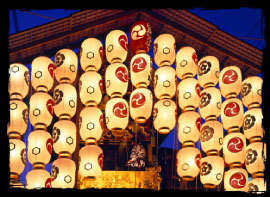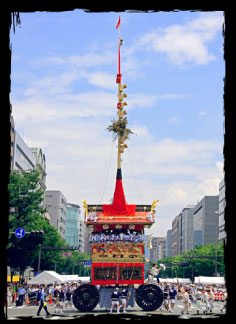|
 |
 |
 |
New eco-friendly paper lanterns, for an environmentally friendly Yoi-yama |
 |
| |
When the Gionbayashi music is played on the floats, uniquely shaped decorative paper lanterns called Komagatachouchin lend a rare atmosphere to the Yoi-yama Yamaboko procession scene. In the summer of 2008, the light bulbs used in these paper lanterns were exchanged with fluorescent lamps (60W). There are about 2,200 Komagatachouchin paper lanterns on the 23 Yamaboko floats, and these new lamps were used this year from the 12th through the 16th of July. Compared with the prior incandescent lamps (20W and 40W), the power consumption and carbon dioxide emissions have been reduced by more than 50%, representing a decrease in CO2 emissions of 1.1 tons (Calculations by the Gion Matsuri Yamaboko Federation based on an illumination time period of 30 hours). In addition, fluorescent lamps produce less heat than the prior incandescent lamps, an important merit for their use. While maintaining the old traditions, the modern Gion Matsuri shows modern consideration for the global environment. |
| |
|
|
 |
 |
| Japanese Decorative Paper Lanterns |
|
|
 |
 |
The Symbol of the Gion Matsuri, Wisdom Doing Away With Waste - The Naginata-boko Float |
 |
| |
Thrusting up towards the sky from the intervals between the buildings at the intersection of Shijo and Karasuma St., the Naginata-boko float is the symbol of the Gion Matsuri. Said to ward off evil and pestilence, accounts say that the original naginata (lance) was made by a swordsmith named Sanjo Kokajimunechika during the Heian Period. However, the current naginata tied to the column in the hook is made from bamboo gilded with tin foil. Originally, this float was called "Kuji-torazu" and it was placed at the head of the Yamaboko procession. Children (called "chigo" and considered a manifestation of the guardian deity) used to ride on a different float and dance, but now only a single child rides on the Naginata-boko. The Naginata-boko float weighs about 11 tons, is about 25 meters tall, and the wheels are about 2 meters in circumference making for one huge float, but the float has a life of 5 years, after which it is disassembled and the parts are tied back together. In 2007, a new float was assembled and another was repaired, with old parts used to fix the wheels. This did away with the unreasonable mixture of new and old parts, and avoided waste, vitalizing the theme of "Wisdom Doing Away With Waste." |
| |
|
|
 |
 |
| The Naginata-boko float |
|
|
|

